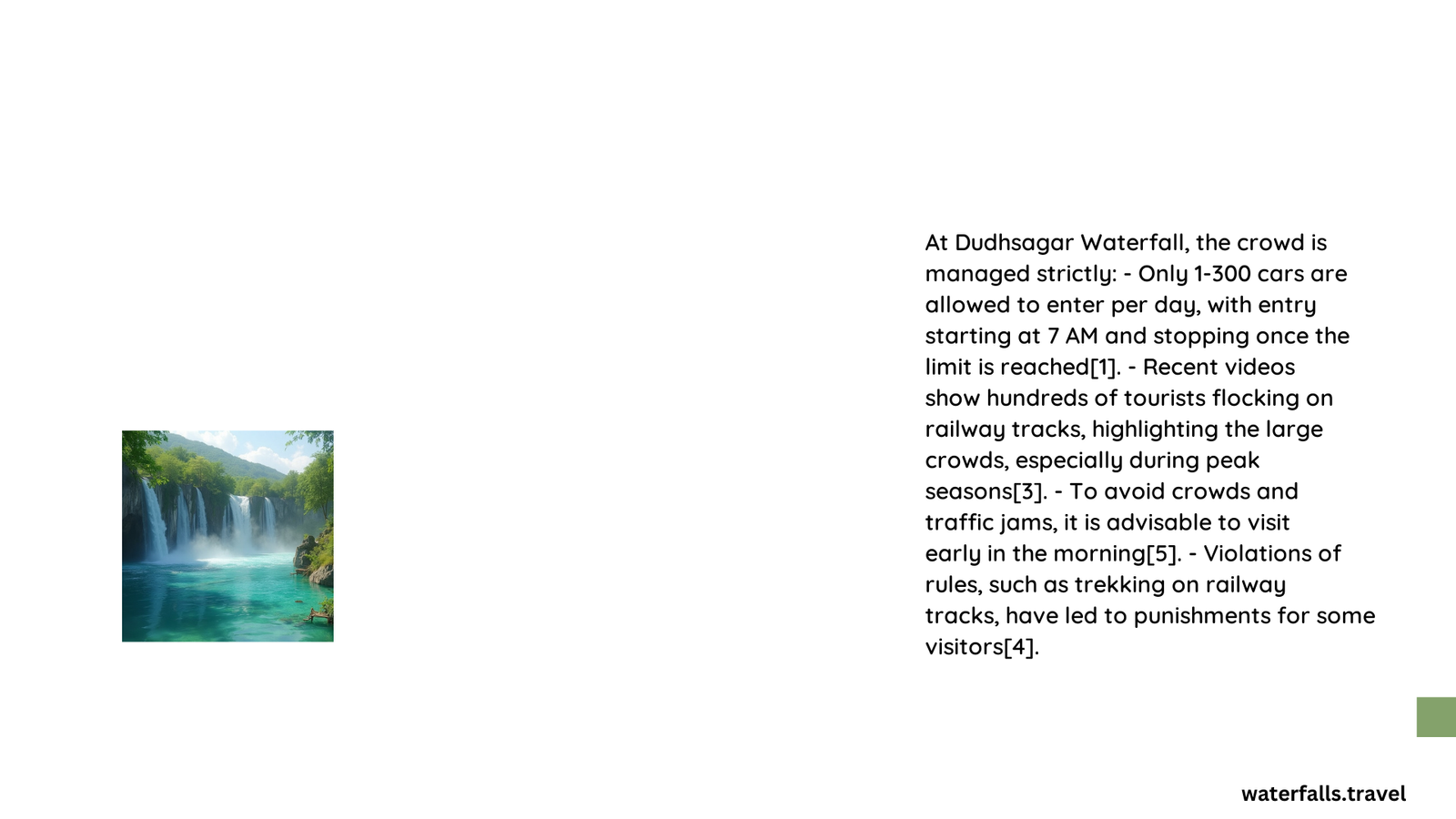Dudhsagar Waterfall, located in Goa, India, is a popular tourist destination known for its stunning four-tiered cascade. The waterfall’s crowd varies significantly throughout the year, influenced by seasons, accessibility, and management strategies. This guide provides essential information about crowd sizes, best times to visit, and tips for managing your experience at this natural wonder.
What is the Average Crowd Size at Dudhsagar Waterfall?
The crowd size at Dudhsagar Waterfall fluctuates based on several factors:
- Monsoon Season (June to September):
- Heaviest rainfall
- Waterfall at its most powerful
- Limited accessibility due to safety concerns
-
Smaller crowds
-
Post-Monsoon Season (October to February):
- Moderate crowds
- Pleasant weather
- Impressive water flow
-
Best time for most visitors
-
Summer (March to May):
- Smaller crowds
- Reduced water flow
- Hotter weather
During peak season, approximately 350 vehicles (110 offline and 240 online bookings) can transport tourists daily, indicating a significant but managed crowd size.
When is the Best Time to Visit to Avoid Large Crowds?

To avoid large crowds at Dudhsagar Waterfall, consider visiting during:
- Post-monsoon weekdays (October to February)
- Early summer months (March to April)
- Early mornings or late afternoons
These times offer a balance between good weather, impressive water flow, and smaller crowd sizes.
How is Crowd Management Implemented at Dudhsagar Waterfall?
Several strategies are in place to manage crowds and ensure visitor safety:
- Online and Offline Booking Systems:
- Goa Tourism Development Corporation (GTDC) manages online bookings
- Dudhsagar Tour Operators’ Association handles offline bookings
-
Limits number of daily visitors
-
Restricted Access:
- Waterfall access limited during monsoon season
-
Specific opening hours enforced
-
Guided Tours and Jeep Safaris:
- Organized tours help manage visitor flow
-
Ensure adherence to safety guidelines
-
Sanctuary Rules:
- Bhagwan Mahavir Wildlife Sanctuary regulations
- Designated areas for visitors
What are the Associated Costs for Visiting Dudhsagar Waterfall?
Costs associated with visiting Dudhsagar Waterfall include:
| Item | Cost |
|---|---|
| Jeep Safari | Varies (book through GTDC or DTOA) |
| Entry Fee | ₹20 for Indians, ₹200 for foreigners |
| Camera Fee | ₹20 for still camera, ₹150 for video camera |
| Parking Fee | ₹30 for two-wheelers, ₹50 for four-wheelers |
Note: Prices may vary; check official sources for current rates.
How Accessible is Dudhsagar Waterfall?
Accessibility to Dudhsagar Waterfall varies based on the chosen transportation method:
- Jeep Safaris:
- Most popular option
- Available post-monsoon and summer
-
Navigates rugged terrain and streams
-
Trekking:
- Option from Kulem to Dudhsagar
- Risky during monsoon (slippery trails, wildlife)
-
Recommended for experienced trekkers
-
Train:
- Nearest stations: Collem or Castle Rock
- Requires additional walking/trekking
- Limited facilities
- Not ideal for full waterfall view
What Should Visitors Know About Dudhsagar Waterfall Crowd?
Key points for visitors:
- Book in advance: Especially during peak season
- Arrive early: To avoid crowds and enjoy better views
- Follow guidelines: Adhere to safety rules and regulations
- Be prepared: Bring appropriate footwear, water, and snacks
- Respect nature: Do not litter or disturb wildlife
By understanding the crowd dynamics and planning accordingly, visitors can have a more enjoyable and memorable experience at Dudhsagar Waterfall.
References:
1. Club Mahindra Blog
2. Times of India
3. Dudhsagar Falls Official Website
